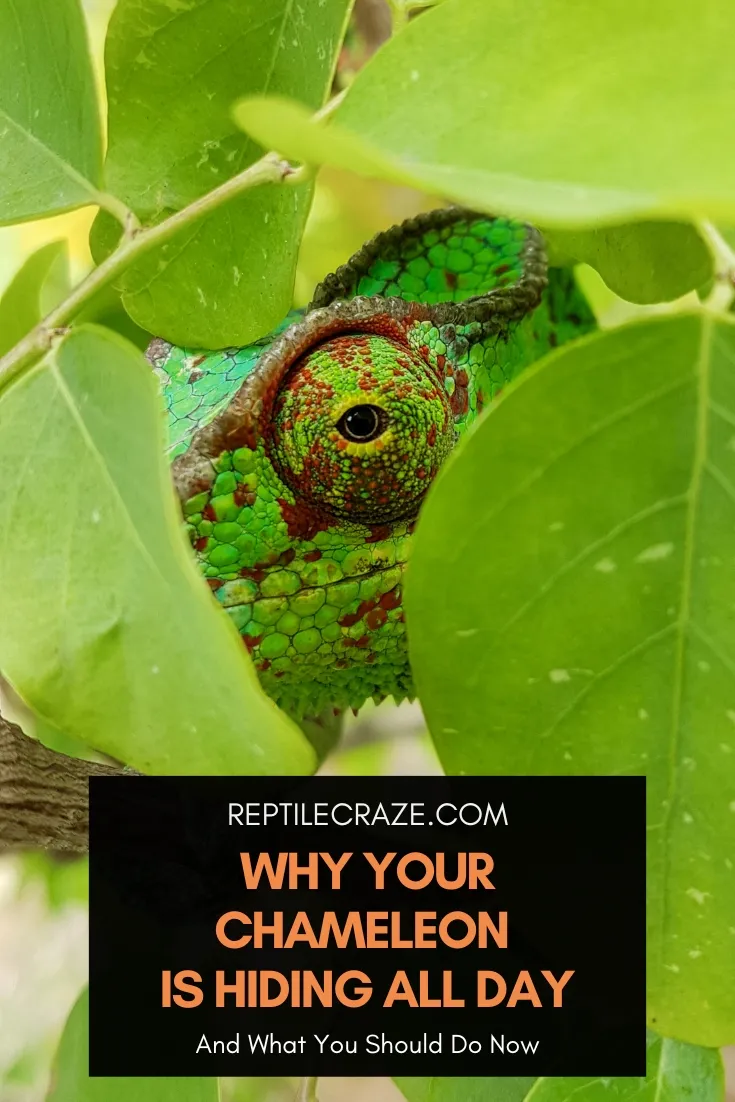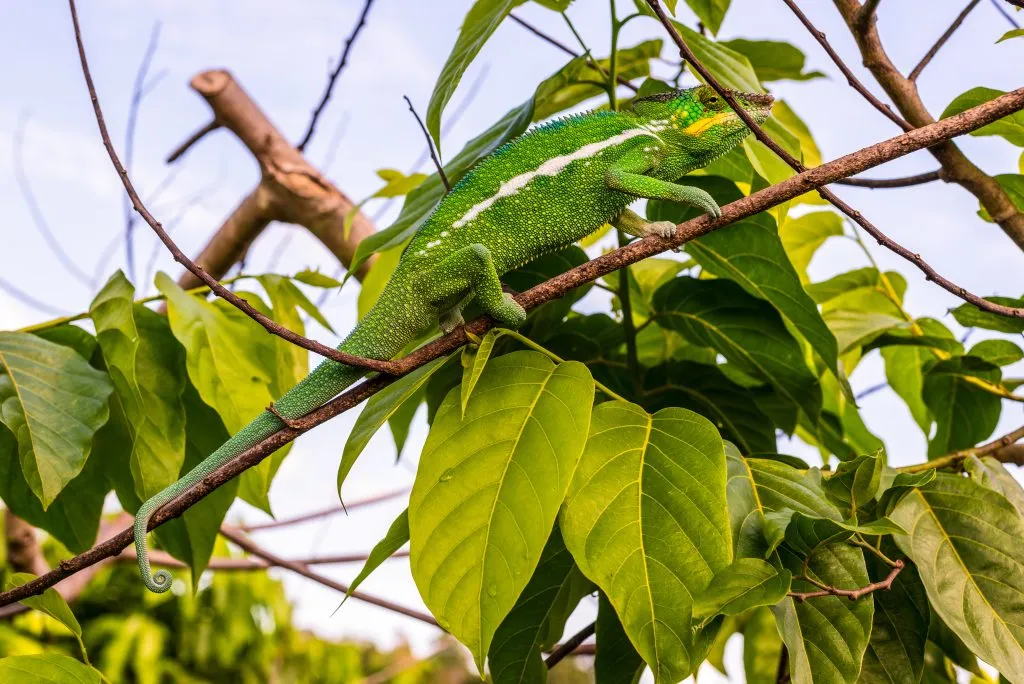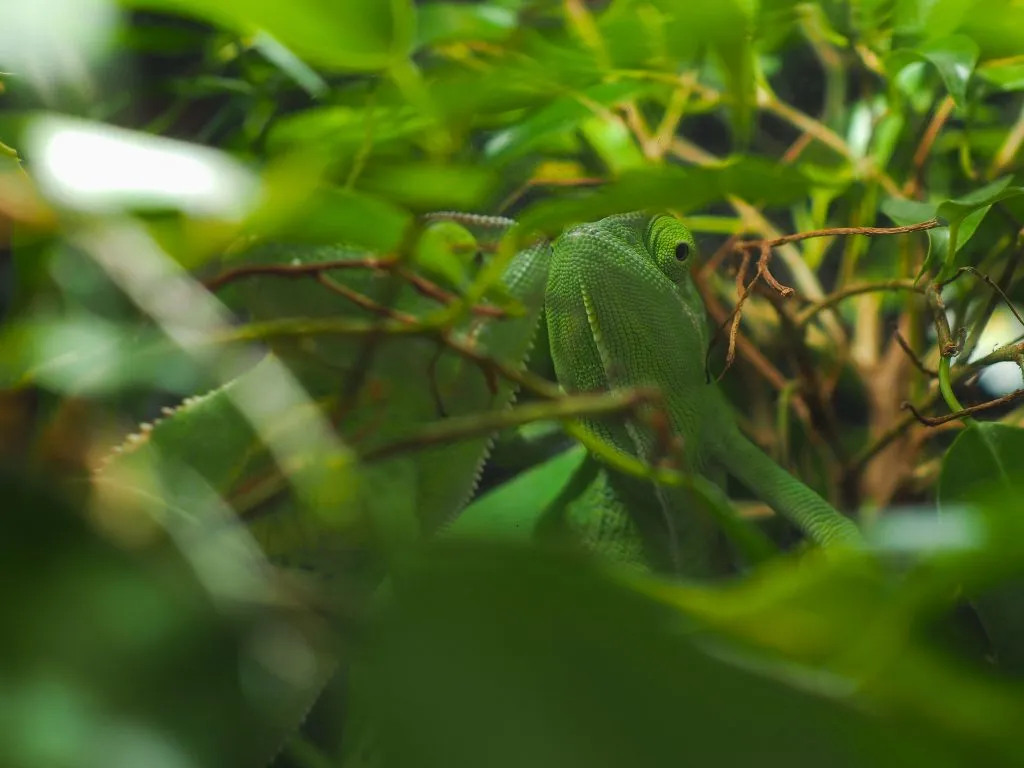
Have you recently noticed your chameleon hiding between the foliage or on the bottom of the
Chameleons are shy reptiles who prefer living alone. They may hide due to natural instincts or for thermoregulation. Chameleons may also hide while adjusting to their habitat, if they experience social stress, or suffer from health issues. Egg laying and shedding may also be linked to hiding.
If your chameleon doesn’t show any other signs of distress, you shouldn’t be too worried. It’s important, however, to understand if this behavior might be caused by some external or internal (diseases) factors. Keep reading to discover more!
Table of Contents
Why Is Your Chameleon Hiding?
Before we explain the reasons why chameleons hide detail, have a look at this infographic to see if you can find a quick answer. Remember that if you’re unsure why your chameleon is hiding, you should take it to a vet for a check-up.

Now let’s have a look at the reasons in detail!
1. Your Chameleon Is New to the Environment
If you’ve recently got your chameleon pet and it’s been hiding a lot, there’s no need to worry. It’s just adjusting to the new environment. Your chameleon may also hide because it’s not accustomed to you yet – you both require time to bond.
Chameleons may also hide if they’re moved to a new
Moreover, most chameleons are not fond of being handled. If you notice that your chameleon goes into hiding after being handled, becomes aggressive in the process, gapes, or puffs, you should refrain from doing this without proper training.
2. Natural Chameleon Anti-Predatory Instincts
Chameleons have many predators in the wild – birds, snakes, and mammals, to name a few. Naturally, protecting themselves from potential predators has become a deeply rooted behavior.
Your reptile may also hide if you have other pets. It will regard them as predators and will try to remain undetected.
Did you know? Even though chameleons can change their colors, they don’t use that ability to hide from predators. Chameleons use this ability for communication.
You should observe whether your chameleon’s hiding behavior can be associated with your cat, dog, or bird coming into the room.
We do know that some pets are zestful creatures, so we can’t blame the chameleon for being extra cautious!
If the hiding is caused by other pets, you should try to limit their interaction.
Otherwise, it can lead to your chameleon experiencing psychological stress, which, in turn, can cause immune suppression and failure to thrive, as per experienced veterinarians.
In any case, your chameleon’s
tank furniture should mimic the colors of its natural habitat – this way, your pet will have the comfort of knowing it will be easy to blend in and hide if necessary.
3. Your Chameleon Experiences Social Stress
This reason may apply to your pet if it’s not alone in the
So if they share their habitat with another chameleon, they’ll rely on hiding as a response to social stress.
It is, in fact, not recommended to house chameleons with others of their kind. It is also dangerous to place them in the same
Experts suggest that the only situation in which chameleons can be housed together is if the males cannot see each other.
Did you know that chameleons shouldn’t be placed in glass-walled enclosures? They’ll see their own reflection and may show aggression toward it. They don’t have the ability to understand the concept of reflection and will try to defend their territory. That’s how far social stress can go with chameleons.
Social stress may also occur during the breeding season when you introduce the male chameleon to the female. While adjusting to each other, they may hide to feel comfortable. If they’re ready to mate, lucky you!
After copulation, you may notice the female chameleon hiding. This can happen if the male accidentally scratches the female during mating. However, this isn’t as common as other situations discussed in this article.
4. Your Chameleon Hides for Thermoregulation

Chameleons are ectotherms – this means they regulate their body temperature based on their environment.
Therefore, they require an external heat source to be able to raise their body temperature. Conversely, they’ll move to colder places if they heat up too much.
As such, your chameleon may be hiding if the temperature in its
tank is too high. In this situation, you may notice it hiding at the bottom of its cage or in any other shady spot.
This is a sign that you should check the temperature gradient of the cage. The temperatures may vary depending on your chameleon’s species.
For example, veiled chameleons require a basking area temperature of around 95-110°F and a daytime ambient temperature of 80-88°F. During the night, temperatures should range between 65 and 75°F.
Moreover, you may notice your chameleon hiding among leaves right after basking. This way, they try to avoid excessive heating.
Also read: 6 Reasons Why Your Chameleon Is Shaking
5. Your Chameleon Is Preparing to Lay Eggs
Female chameleons will dig holes to lay their eggs in. Some have been observed sleeping or hiding in these holes before laying and burying the eggs.
If you haven’t bred your female and are not aware that she is about to lay eggs, you may find this behavior disturbing and think of it as a hiding instinct.
You shouldn’t worry, though, as females may lay eggs even if they’ve never seen a male! Moreover, it’s a natural behavior before laying eggs – they just want privacy.
On the other hand, you should still keep an eye on your female chameleon, especially if she remains in the hole for too long.
A chameleon owner reported that their female remained in the hole for two days, and when they checked on her, she was injured and lying face down in the tunnel.
6. Your Chameleon is Preparing to Shed
Adult chameleons typically shed once every eight weeks. Younger reptiles shed more often – around every three to four weeks. Many chameleon owners reported that their pets kept hiding and exhibiting lower energy and appetite loss before shedding.
If your pet’s behavior is accompanied by the following signs, there’s nothing to worry about, as it’s probably related to shedding:
- Dull colors
- Rubbing against the cage
- Puffing out its eyes
However, if these symptoms persist after the shedding process is complete, there may be an underlying health condition causing your chameleon to hide or behave strangely. In this situation, it’s recommended to see a vet.
7. Your Chameleon Shows Signs of Health Issues

Chameleons may hide if they are ill. Hopefully, this isn’t the case with your pet, but you should still check for any concerning signs.
This might be tricky, though, because a chameleon’s natural instincts imply that showing signs of illness makes it look weak to potential predators. Therefore, if your pet keeps hiding in an unusual spot, you should rule out any illnesses.
Here are some other signs your chameleon may show if it’s sick:
- Decreased appetite
- A dull or dark color
- Sunken eyes
- Unusual poop consistency
- Weight loss
- Lethargy
- Inability to climb
- Sleeping during the day
If your chameleon appears to be sick or if you are worried that your chameleon might be dying, please have a look at our article on this topic. It will help you find out if your chameleon is dying and tell you what you should do.
Also read: These Are The 3 Most Expensive Chameleons!
- Enchi Ball Python: A Unique and Stunning Morph of Python regius - March 27, 2025
- Emerald Tree Monitor: The Enigmatic Green Guardian of the Rainforest - March 26, 2025
- The Egyptian Cobra (Naja haje): A Fascinating Serpent - March 25, 2025
